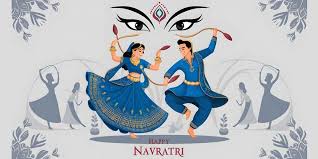Nine nights of celebration, nine lessons for life.
India is often described as a land of festivals. From harvest gatherings in villages to grand city processions, celebrations form the heartbeat of our culture. Among these, Navratri holds a unique place. For nine days and nights, communities across the nation come alive with colour, music, and devotion. From the garba in Gujarat to the Durga Puja pandals of Bengal, the festival brings people together in a spirit of unity. But while we witness the grandeur, it is equally important to reflect on what Navratri really teaches us. Yet, beyond the rituals and celebrations lies a profound message which very few of us know about. What is it? Not many of us know that the festival of Navratri is not just about worshipping the goddess, but about remembering the role of feminine power in sustaining society. In a country where respect for women is deeply woven into our cultural roots, Navratri is a reminder that progress cannot be measured by material success alone.
True prosperity flows when we honour values such as purity, compassion, strength, and wisdom. Traditional stories retold during Navratri carry this message in a symbolic form. The tale of Goddess Durga defeating Mahishasur is not merely a myth, but an allegory. Mahishasur represents the arrogance and ignorance that destroy harmony, while Maa Durga embodies courage and righteousness. Hence, her victory shows that whenever society slips into imbalance, it is the rise of inner virtues that restores peace. This symbolism is also reflected in the rituals we follow during Navratri. Lighting the akhand jyoti represents knowledge that removes the darkness of ignorance. Worshipping young girls is not just ritualistic; it is an affirmation that innocence, purity, and future potential must be valued. Fasting is not simply about dietary control but about learning self-restraint. Thus, each tradition, when understood, becomes a practical lesson for living. Navratri also highlights the spirit of community. It is rare to see such large gatherings where music, prayer, and dance blend seamlessly. Whether it is garba in the West, Golu displays in the South, or Durga pandals in the East, the essence is the same — that of celebration of collective harmony. In an age where individualism often dominates, Navratri reminds us of the strength of togetherness. It tells us that culture is not preserved in isolation but in shared experience. For the youth especially, Navratri offers both joy and guidance. While dance and festivities bring energy, the stories and rituals provide direction. They teach that beauty lies not in appearances but in values, and that true power is the ability to rise above negativity. In this way, Navratri links the joy of celebration with the seriousness of character-building. As Bharat moves forward, it is vital that festivals retain this dual role of celebration and reflection. If we focus only on rituals and forget their meaning, they risk becoming empty customs. Looked at more deeply, they become instruments for shaping a balanced society.
Navratri is one such occasion where devotion, culture, and wisdom converge. This year, as we witness the colours and music of Navratri, let us not forget its essence. The goddess we worship lives in every act of kindness, every choice of courage, and every moment of wisdom. By respecting women, nurturing values, and uniting as communities, we truly honour the spirit of the festival.
